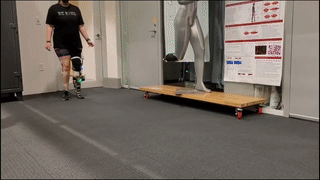
Modulation of Prosthetic Ankle Plantarflexion Through Direct Myoelectric Control of a Subject-Optimized Neuromuscular Model
HomeAbstract—The ideal neuroprosthetic control paradigm minimizes disparities in dynamic performance and subjective embodiment between artificial and intact physiology. In this letter, we address the former by introducing the Activation Mapping paradigm, a cascaded optimization procedure that enables a subject with unilateral transtibial amputation to neurally modulate the torque developed during prosthetic ankle plantarflexion. Specifically, in the first stage, the optimization procedure develops a digital locomotor clone that recovers symmetric gait dynamics for the hypothetical subject prior to amputation. In the second stage, the resultant ankle torque-angle trajectory serves as a reference to optimize over the morphological parameters of a neuromuscular ankle model. The optimized model contains a single agonist-antagonist muscle pair driven by a recording of the subject’s within-socket walking electromyograms that reproduces the reference ankle dynamics. In this manner, the subject’s natural residual muscular activations are mapped to their idealized gait dynamics to form a one degree-of-freedom neuromuscular ankle controller. The subsequent implementation of the activation map on a powered ankle prosthesis enables the subject to not only generate physiological ankle dynamics to increase their self-selected walking speed from 1.22 m/s to 1.33 m/s, but also to volitionally perform bilaterally symmetric standing calf raises while balancing for at least 2.0 seconds.
Paper